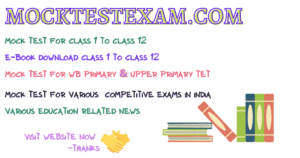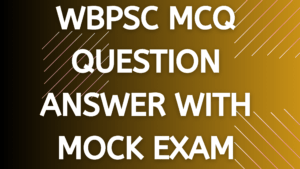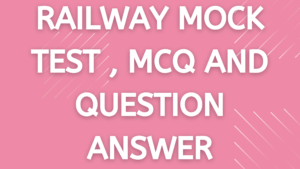
WB SSC Work Education Important MCQ
wbssc pt question paper pdf
ssc philosophy question paper
slst education question
mcq questions for class social
chapters mcq questions for class
assistant teacher previous question papers
wbssc assistant teacher previous question
download previous years work education
previous years work education question

WB SSC Work Education Important MCQ
Tags
কর্মশিক্ষা Syllabus
GUIDELINE FOR WORK EDUCATION (PASS)(CODE-34)Mode of Selection Selection of the Assistant Teachers (Work Education) in different
Madrasahs shall be made on the basis of written (MCQ) examination,
Evaluation of academic qualifications of the candidates as per NCTE
guidelines and personality tests to be determined by the Commission in the
following manner:
(a) Written Examination : 55 mark
(b) Academic qualifications including professional qualifications : 35 mark
(c) Personality Test
: 10 marks
(Appearance before the Personality Test Board is compulsory)
Question Paper Pattern
and marks allocation
There shall be 55 questions of MCQ type carrying one mark each and no
negative marks. Group – A (28 questions) — it is compulsory. Out of other
three groups B, C and D (each Group has 27 questions), answer from any
one Group (as opted by the candidate).
Question Papers Will be set in English and Bengali (both)
Duration of ExaminationOne hour
Date & Time Will be announced later
Syllabus Group – A (Marks – 28)
1.
i. Place of Work Experience in General Education as envisagedbytheEducation Commission 1964-66
ii. Concept of Socially Useful Productive Work as designedbyI.B. Patel
Committee.
2.
i. Purpose of Work Education as an Activityapproach in the curriculum of Secondary EducationinWest Bengal.ii. Difference of Work Education with Vocational Education –
Pre-vocational experience.
approach in the curriculum of Secondary EducationinWest Bengal.
3. Bases of Work Education-philosophical, psychological and sociological. The‘Four Pillars’ of educational foundation as determined by UNESCO’s
International Commission on Education Chaired by Jacques Defors (1996).
Learning to know, to do to live together and to be – Work Educationintegrates all these four pillars.
4. Behavioral changes expected out of the Programme of Work Education –development of attitude, acquisition of skill and gaining of knowledge.
5.
(i) A general idea of the syllabus in Work Education prescribedfor WestBengal, with a good grounding in the
WB SSC Work Education Important MCQ
projectsincludedinthesyllabus(a) the Exposure Stage and
(b) the Involvement Stage.
(ii) Scope for change in existing syllabus.
6. Project method applied in teaching Work Education – how to integrateDiscussion Method, Demonstration Method and Socialized Recitation with projectmethod
7. How are work projects related with other curricular subjects – need for
involvement of the Headmaster, other subject teachers and parents.
Edgar Dale’s Cone of Experience – improvised low-cost teaching aids application
of other media in implementing projects.
8.
i. Consideration for selecting work project in
(a) urban school and
(b) moffusil school
ii. Occupational exploration and field-study
iii. Utilisation of human and material resources
iv. Difficulties, if any, faced by schools in implementing work projects –
suggestions for overcoming those difficulties.
9.
i. Assessment of procedure in Work Education – tools for evaluation-present
system.
WB SSC Work Education Important MCQ
ii. Suggestions for improvement in evaluation process feasibility or not of
introducing a short written test ( of, say, 20 marks) in lieu of viva-voce, of
the Final Madhyamik Pariksha.
Group – B (Marks – 27)
Process of growing/preparation, materials and equipments required etc. for workprojects as well as usefulness of the products, work-areas to be convered are as
follows:
1. Cereals (Paddy, Wheat) & Cash crop (Jute)
Varieties – preparation of seedbed – sowing, drilling and transplantation – organic
manure and compost making- chemical fertilizer-inter culture – irrigation and
water requirements – pest and weed control – harvesting.
Making of food products from cereals.
2. Growing Vegetables and simple Medicinal Plants
Soil fertility – major, secondary and micro-nutrients-organic manure and chemical
fertilizers – tillage of seeded -manuring-sowing and transplantation – inter culture –
irrigation and water requirements – disease and pest control – harvesting.
Preservation of vegetables. Process of growing medicinal plants. Use of medicinal
plants in our daily life.
3. Flower and Fruit Plantation & Preservation
Different kinds of seasonal flowers – planning of an ideal garden – soil preparation- compost making – planting, mulching, pruning and training methods of
propagation – weeding. Pot culture. Use of flower and scope of marketing.
Preparing & garden for fruit cultivation – preparation of jam, Jelly and pickle – food
processing, preservation, and packaging.
4. Tailoring & Embroidery
Drafting and pattern making, cutting and construction, Cutting and finishing or
underpant, pyjama, salwar, petticoat, blouse, kameez, shirt, trouser. Embroidery
on garments — different stitches and application, appliqué, mirror work etc.
5. Paper & Cardboard work and Making of Household Articles
Materials and techniques of paper-cutting, office file, greetings cards.
Book-binding: Jus stitch-Limp binding – Flash cut binding – conver wrapping
binding.
Household articles made from jute or bamboo; preparation of fashion goods by
cloth, clay, paper or cardboard; making flower and flower-vase using plasticine;
making photo-frame with waste materials; earing of bag and making of dolls by
cloth and cotton.
6. Designing, Dyeing and Batik Printing
Basic design and technique. Simple dyeing. Tie and dye and Batic processes.
7. Fabric Plainting and Screen Printing
Basic designing – colour application – spray printing – stenciling. Silk Screen printing- material and techniques.
8. Soap and Phenyl making
Varieties of soap: hard and soft – consistency of soap – raw material: oils and fats,
fatty acid, resin, caustic soda – determination of hardness through soap stock –
work education Syllabus
specification solubility ratio. Various methods of manufacture:
(a) cold process (b) semi-boiled process (c) full-boiled process
preparation of soft soap and phenyl.
9. Household Electrical Gadgets Repairing
Verification of Ohm’s Law – wires used in internal wiring – method of earthling –
fitting of C.T.S. Wiring in residence – determination of fusing constant by test –
conducting routine tests on the wiring insulation – location of fault – dismantling
and study of parts with sketches of electrical fan, fluorescent lamp, heater,
electrical iron, calling bell etc. – how to convert from AC to DC and vice-versa.
10) Computer Application
(a) Computer Fundamentals : Computer Generations, Block diagram of a
Computer and brief description of each functional block, Input and Output devices
(Keyboard, Mouse, VDU, CPU, ALU and Control Unit), Primary memory, CACHE
Memory, concept of Hardware and Software, Language translators, Programming
Languages, concept of Operating System, Familiarity with Operating System
environment through GUI.(b) Word Processing: Creating, Editing, Formatting, Saving and Retrieving
documents, checking spelling and Grammar, Finding and replacing text, creating
multiple columns, inserting graphics within text, equation editor and its use,
Protection using password, creating macro, Mail Merge, Printing of documents.
(c) Spreadsheet: Creating, Edition, Saving and retrieving documents, creating and
modifying tables, creating and generating charts using data sheet, working with
equations and excel library function, Pivot table, use of hyperlink and macro in
excel spread sheet, use of filter option.(d) Computer Networking: Concept about network, Network structures, LAN,
MAN, WAN, Internet, broadband connection, email, chatting, w.w.w. , U.R.L.,
D.N.S., Search engines.
(e) Presentation Package: Creation of a lesson unit through presentation package.
Indian Art
Group – C (Marks – 27)
General Background of Indian Art / Constraints of Indian Art Development.
Evaluation of Indian ArtSculpture
কর্মশিক্ষা Syllabus
1. Art of Indus Valley Civilization
2. Art of Maurya : Asokan Pillars
3. Early Buddhish Art of India from Sunga to Ajanta, Sanchi. Kushan :
Gandhara & Mathura. Amaravati. Gupta Period : Sarnath, Ajanta4. Art of Mahabalipuram : Ellora, Konarak, Chola Bronze : Nataraj
5. Miniature Paintings of India-i) Mughal & ii) Rajput
6. Bengal Art Tradition-i) Terra Cotta Temple of Birbhum &
Bishnupur, ii)Pata Chitra, iii) Kalighat Painting, iv)Basic Elements in
art of painting
7. Abanindranath Tagore, Rabindranath Tagore, Amrita Sher-gil,
Jamini Roy, Nandalal Bose, Benode Behari Mukhopadhyay, Jainul
Abedin, Somnath Hore, M.F. Husain, Meera Mukharjee,
Chittaprosad Bhattacharya, Gopal Ghose, S.H.Raza, Francis
Newton Souza
Western Art
1. Prehistoric Art : Altamira Cave Painting
2. Egyptian Art
3. Greco-Roman Art
4. Italian Renaissance Art
5. Art Work of Giotto in Death of St. Francis, Leonardo da Vinci in
Last Supper & Monalisa, Raphael in Madonna, Michelangelo in
Pieta & Sistine Chapel Ceiling, Rembrandt in Night Watch,
Vermeer in Lace Maker & Head of a girl with pearl earring,
Bruegel in Crucifixion
6. Baroque and Rococo in the contribution of Van Eycks( Dutch ) in
Rainbow & Alterpiece of Lamb
WB SSC Work Education Important MCQ
7. Classicism, Romanticism, Realism (1800-1818AD) in the
contribution of Tumer(British) in Rain, steam, speed &
Constable(British) in Landscapes
8. Impression of Mordern Art in the contribution of FrenchmanManet in The Fifer, Monet in Water Lilies, Cezanne in Still life with
apple, Matisse in The open window, Rodin in Thinker ,
9. Spanish Art Contribution of Picasso in Guernica, Dali in The
persistence of memory ,
10. Art Contribution of Dutchman- Van Gogh in Sunflower,RomanianBrancusi in Bird in Space and Swisse-German- Paul Klee in
Forgetful Angel, Conjuring Trick
11. Art contribution of modern Artist like Jackson Pollock, Mark
Rathko, Mondrian.
Creative Handicrafts/Design/Photography
Theory on i) Preparation of common clay ii) Uses of various hand tools &
equipments for wood work . iii) Batik : Method & Meterials, preparation & use of
Batik colour. Iv) Method, materials & process of mould and plaster casting.
Group – D (Marks – 27)
Performing Art
Music
i. Introduction to Western music with reference to Tagore’s songs
influenced by west.
ii. Ragas like, ‘Bhairabi’, ‘Kedar’, ‘Chayanat’, ‘Pilu’, or ‘Bahar’ ‘Multani’
(‘Bilambito’ & ‘Druto’)
iii. Bhajans of Meera Bai or Kabir Kirtan, Ramprasadi, Nazrul geeti,
Atulprasad, Dwijendra geeti, Rajanikanter gan. Etc.
iv. Tagore’s Songs from ‘Geeti Charcha’ (Part IV) or selected songs from
‘Geetabitan’. Also students be introduced to Tagore’s songs in Tappa
form.
v. Ragas: ‘Iman Kalyan’, ‘Tpdi’, ‘Brindabanisarang’ (‘Bilambita’ & ‘Druto’
Kheyal).
vi. Tagores Song.
vii. Kirtan, Bhatiali. Baul.
viii. Instrumental Music.
ix. Lives of Hindustani Musicians.
x. Musical notes (Saralipi) of Tagores Songs and ‘Druto Kheyal’.
xi. Variations of contents in Tagores Songs and his musical environment
at home.
xii. Dwijendralal Ray, Rajanikanta Sen – their life and music.
xiii. ‘Tal’ (Rhythm): usual and created by Tagore.
xiv. Notes.
xv. Musical notes (Sarolipi) of ‘Druto Kheyals’.
xvi. Influences of musics in Child hood of Rabindranath & his teacher.
xvii. Atulprasad Sen, Kazi Nazrul Islamxviii. Usual ‘Tal’ (Rhythm) & ‘Tal’ created by Rabindranath.
Dance: In Primary classes dances with easy forms and postures should be taught
as prescribed by the teacher. Dances should include ‘Bratachari Nritya and other
popular folk dances and other classical dances in India.
Theatre:
A. Sukumar Roy (‘Abol Tabol’, ‘Khai Khai’, etc) and Rabindranath Tagores
(‘Sishu’, “Shey’, ‘Birpurush’ etc.) ‘Pagla Dasu’, ‘Khai Khai’, or ‘Abak Jalpan’ of
Sukumar Roy and Tagore’s ‘Ichhapuran’ or ‘Siburam’ from ‘Shey’.
B. ‘Rapid Reader’: ‘Tuntunir Galpo’ and ‘Chotoder Ramayan’ (Upendra kishore
Roy Chowdhury), ‘Maku’ and ‘Padipishir Barmi baskho’ (Lila Mazumdar),
‘Sukholata Rao er Galpo’, ‘Feluda’, Prof. Sanku and other stories of Satyajit
Roy .
C. Pathonatika, Modern Theatre and the influence by the West


